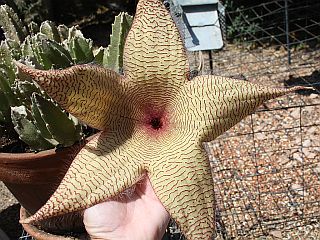 Damsel took this picture of one of my favorite plants. It’s called Stapelia Gigantea and is a cactus-like succulent native to the African continent. I like it, but not because it has pretty flowers, not because of lavish green stalks and certainly not because it smells good.
Damsel took this picture of one of my favorite plants. It’s called Stapelia Gigantea and is a cactus-like succulent native to the African continent. I like it, but not because it has pretty flowers, not because of lavish green stalks and certainly not because it smells good.
Every summer, the plant produces several pods that grow like great pointed balloons and then explode into five-pointed, hairy flowers that produce an aroma of rotting flesh. While flowers are in bloom, the flies flock to it and consequently keep out of the patio area. I like that about it – it’s sorta like a fly trap.
That’s Damsel’s hand lifting the drooping starfish up to be photographed. The plant can be seen at the left. Click on the image to enlarge.
Here’s more information about this exotic stinker that I lifted from UBC Botanical Garden:
As with many plants, Stapelia gigantea has a suite of common names. These include carrion flower, giant toad flower, Zulu giant, starfish flower and (in Australia) dead horse plant. Most of these are fairly descriptive – it does smell like carrion, it comes from Africa, it’s big, it resembles a starfish and it attracts flies like a dead horse. I haven’t been able to deduce the reason for toad flower, though (perhaps also because of the flies?).
You have probably guessed that this odd plant is pollinated by the blow-flies it attracts.
I should sneak in that Stapelia gigantea is considered an invasive plant in Hawaii and a weed in Australia.

A rotting corpse starfish flower that draws disease laden flies like a hellish magnet.
What’s not to like?
The only way this flower could get any better is if it followed you around the house screaming like a banshee, crapping on the carpet and using your credit cards to buy maggot pizzas.
Sounds appetizing from a ‘Lord of the Flies’ perspective.